Have you heard about the health benefits of sauerkraut and are looking to try some but have no idea what to buy? Or, where to buy it?
What is the Right Stuff to buy?
You can’t just head down to your local grocery store and grab a can off the shelf.
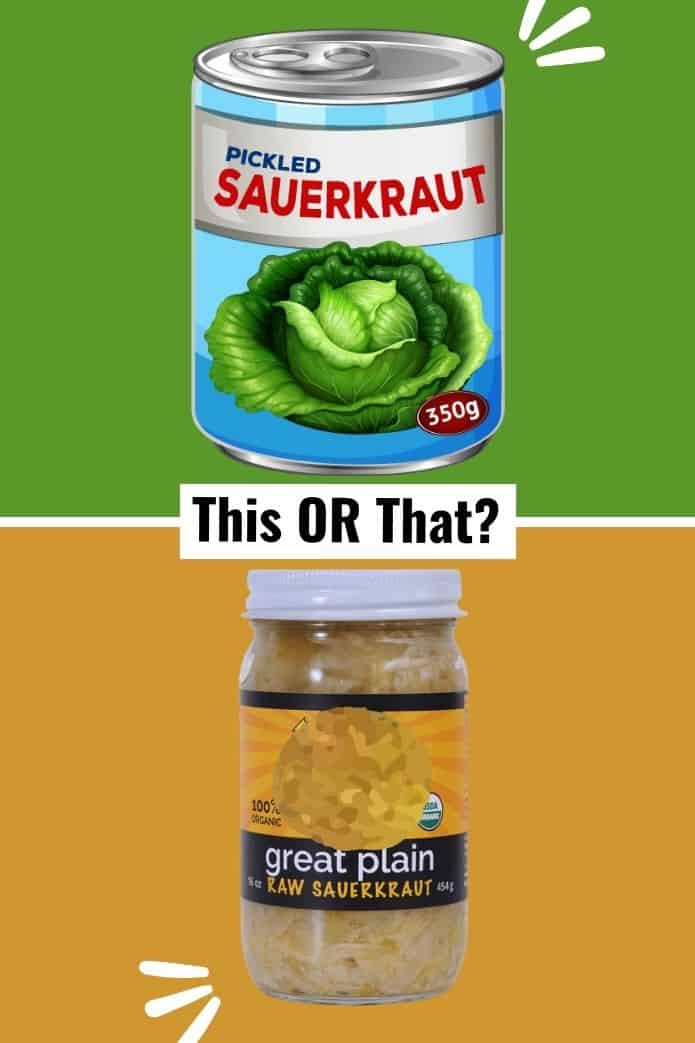
This is NOT the Right Stuff!
The Right Stuff is sauerkraut that is alive!
Sauerkraut that is alive contains beneficial bacteria that deliver countless nutrients, support your immune system, and boost your digestion.
The Right Stuff also is the best-tasting sauerkraut.
We all want that. Right?
Read on to discover what to look for when buying sauerkraut so that you buy the Right Stuff.
Buy the Right Stuff! FREE Download
Use the button below to get your own printable Sauerkraut Shopping Guide.
What is Sauerkraut?
Sauerkraut, or “fermented cabbage” is a food that is made by a process called Lacto fermentation, the same process used to make traditional cucumber pickles and kimchi.
To make sauerkraut, finely sliced raw cabbage, and usually, some other vegetables and spices are mixed with salt and are then packed into a vessel to ferment.
Naturally occurring lactic acid bacteria eat the sugars in the cabbage leaves to create lactic acid, a natural preservative, digestive aid, and source of the unique sour flavor.
This naturally fermented sauerkraut has a deeper flavor profile than canned sauerkraut and is the best-tasting sauerkraut.
Most sauerkraut in your local supermarket is pasteurized—cooked at high temperatures—and afterward canned.
Though canning makes for a shelf-stable product, the process kills off the beneficial probiotic microorganisms that our body needs.
Why Eat Sauerkraut?
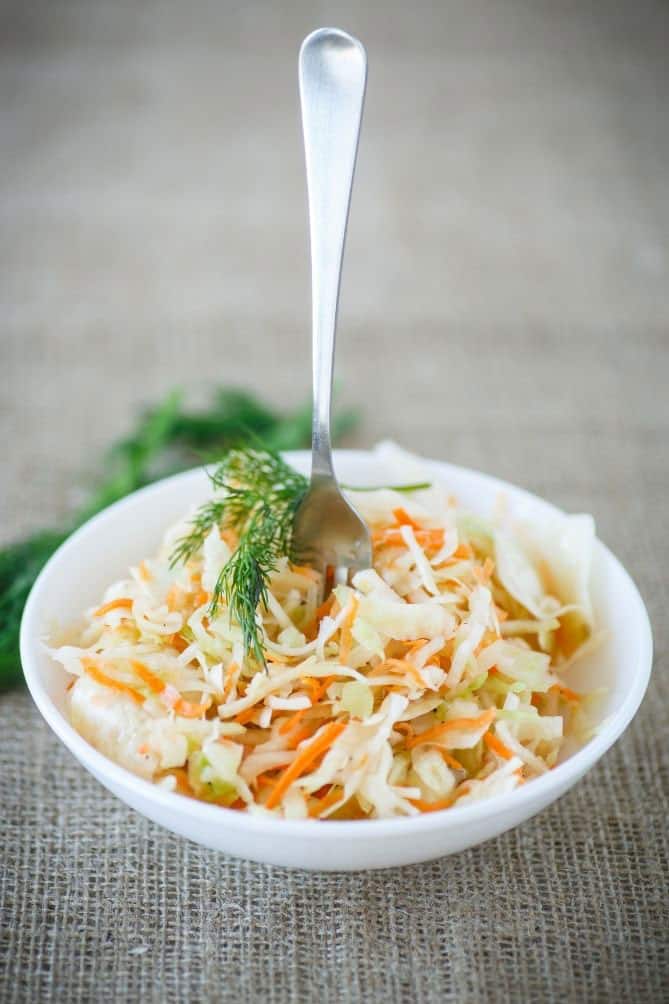
Here are a few of my favorite reasons:
Sauerkraut tastes delicious!
Sauerkraut is easy to eat with just about anything!
Sauerkraut unlocks the flavors in any dish!
Sauerkraut is rich in nutrients!
And… with the consumption of just a forkful daily, you:
Support Your Immune System
Most people, and many physicians, do not realize that 70–80% of the cells that make up your immune system are found in the walls of your gut.
The consumption of fermented foods supports the health of the gut lining (mucosa) as a natural barrier.
A lack of beneficial bacteria allows disease-causing microbes to take hold in your gut, causing inflammation in the gut wall, or even slipping through a weakened gut wall and running rampant in the rest of the body.
Boost Your Digestion
By eating a variety of fermented foods, you supply your digestive tract with a wide range of beneficial bacteria that help promote the growth of healthy flora in your intestines.
This makes for better digestion, which makes for better health.
Having a healthy balance of gut flora and plenty of digestive enzymes ensures that you will absorb more of the nutrients in the foods you eat.
When your gut flora is out of balance, you can’t absorb all the nutrients from the foods you eat.
In addition, eating sauerkraut can compensate for decreased production of hydrochloric acid, our stomach’s natural secretion that decreases as we age.
Hydrochloric acid acts as a barrier to prevent harmful bacteria and parasites from invading your digestive system.
Hydrochloric acid also improves digestion in your stomach by breaking down food so it can be absorbed by the small intestine. The lactic acid from sauerkraut can partially compensate for reduced hydrochloric acid.
Sauerkraut Tastes Incredible
Fermentation is a process that creates an awe-inspiring shift in the flavors of the food being fermented.
These ancient practice changes grapes into wine, barley seeds into beer, milk into a whole smorgasbord of cheeses, flour into sourdough bread, soybeans into miso, cacao beans into chocolate, pork into prosciutto, cucumber into pickle, and cabbage into sauerkraut or kimchi.
Now that you’re salivating, need I say more?
Umami, which is Japanese for “pleasant savory taste,” refers to glutamate—a type of amino acid that occurs naturally in many foods.
When glutamate breaks down through fermentation, it becomes L-glutamate, and that’s when things start to taste really good.
The presence of L-glutamate is why properly sauerkraut not only tastes delicious on its own but also makes the foods you’re eating it with taste incredible.
More on sauerkraut nutrition, here to include the many strains of bacteria found in sauerkraut. And for some more reasons to consume sauerkraut:
Why else should you eat sauerkraut?
3 Vital Things to Look for When Buying Sauerkraut
To reap the health benefits of consuming naturally fermented foods, you need to make sure that the store-bought sauerkraut you buy is still teeming with the beneficial bacteria, enzymes, and nutrients created during the fermentation process.
Here’s what you need to be aware of when looking for the Right Stuff.
The Right Stuff is Found in the Refrigerator Section

Look for sauerkraut in the right place.
Sauerkraut is alive and will continue to ferment past its peak stage unless kept at a stable temperature.
For this reason, the Right Stuff is typically sold in the refrigerator section of health-food stores, at farmer’s markets, or at some of the more progressive grocery stores.
Most grocery store sauerkraut is not going to be full of those marvelous mighty microbes that you’re looking for.
If it’s on a shelf down one of the aisles or it’s in a can—the stuff is dead—leave it on the shelf!
A shelf-stable product is easier to manage for companies and stores, but your health is too high a price to pay for that convenience.
So, head straight to the refrigerator section of your local health-food store and look for the Right Stuff!
Not All Sauerkraut Found in the Refridgerator Section is the Right Stuff
Don’t be fooled by Bubbies sauerkraut, a popular store-bought sauerkraut usually sold in the refrigerator section.
Bubbies, by law, has to “partially” pasteurize their product for “shelf stability.”
This means that it isn’t devoid of probiotics by any measure, but it won’t have nearly as many probiotics as the Right Stuff. From their website:
Bubbies Sauerkraut is not raw, but it is definitely still full of good bacteria. Bubbies Sauerkraut undergoes a mild heating during packing which raises the product above the raw threshold of 118 degrees, but to no more than 135 degrees resulting in a loss of approximately 10% of the active cultures that formed during the initial fermentation.”
—Bubbies website
The Right Stuff is Alive!
Look on the label for the right words to signify that the sauerkraut is alive.
Most sauerkraut found in a grocery store is pasteurized and then canned and found down an aisle along with the canned tomatoes and beans.
Pasteurization, while an important process for the preservation of many foods, does more harm than good to sauerkraut. A shelf-stable product is easy to manage, but the price is high for that convenience:
The fermentation process creates live lactobacillus bacteria and other beneficial microbes, which die when sauerkraut is heated.
Both Vitamin C and the lactobacillus probiotic bacteria found in sauerkraut—responsible for helping you with your digestion—are killed during pasteurization.
Check the package and look for words such as:
“Raw”
“Perishable”
“Unpasteurized”
“Keep refrigerated”
“Naturally occurring Lactobacilli“
“Naturally fermented”
“Third-Party tested and lab-verified to contain probiotics*”
The Right Stuff is NOT cooked… NOT canned… NOT pasteurized… NOT heated in any way!
Sauerkraut in a Pouch
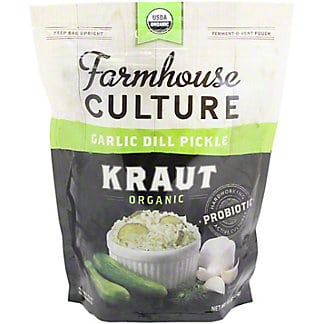
Don’t be surprised if the stuff you are looking for is not sold in a jar.
Farmhouse Culture, whose products are found at California Bay Area farmer’s markets and at stores across the U.S., is the first company in the nation to pack their sauerkrauts and Kimchi in a pouch.
From their website:
Raw kraut is a living, breathing food that when packed into jars, can bubble over or can make it nearly impossible to remove the lid. The ferment-o-vent releases this natural build up of pressure without letting in harmful bacteria. The pouch contains no BPAs…”
This Lid Most Likely Signifies that the Suaerkraut has Been Pasteurized
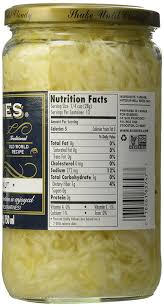
This style of lid is used when pasteurizing and canning a food product. Unless the label indicates that the sauerkraut is not heated, this sauerkraut is not the Right Stuff.
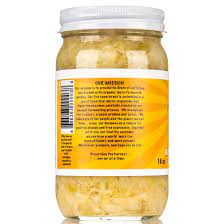
This style of lid, one that screws on, most likely indicates that the sauerkraut has been naturally fermented and still contains beneficial bacteria and enzymes.
*Third-Party tested and lab-verified to contain probiotics
You may be lucky to find a brand that sends samples of their sauerkraut to a lab to be tested for probiotics. The following was found on one brand of sauerkraut:
3RD PARTY TESTED AND LAB VERIFIED TO CONTAIN PROBIOTICS, our sauerkraut contains 14 billion colony forming units (CFUs) of lactic acid bacteria per serving (including Lactobacillus Plantarum, L. Brevis, Leuconostoc Mesenteroides, Pediococcus Acidilactici, and P. Cerevisiae).
The Right Stuff Contains “Only” Cabbage and Salt
Look on the label to verify that only real ingredients are listed.
Raw, fermented organic sauerkraut is made with just cabbage and salt and, some yummy vegetables—like carrots, ginger, garlic, and cumin seeds—for flavoring,
Read the ingredients list on the label. Does the list start with cabbage, perhaps include some other vegetables and spices, and list salt?
What you should NOT see on the label:
Vinegar. Vinegar is used as a preservative in pasteurized sauerkraut. The natural fermentation process generates its own healthy lactic acid and other organic acids that preserve the sauerkraut.
Sodium Benzoate, Sodium Bisulfate, or other strange-sounding stuff. These are preservatives that are not necessary. In traditionally fermented sauerkraut, plenty of lactic acid is produced to preserve the sauerkraut.
Sugar. Don’t buy this Imposter! Note: Kimchi often contains sugar, which is fine.
Starter Culture
You might find “starter culture” on the label, which is fine. Some companies use a starter culture to boost the number of beneficial bacteria at the beginning of the fermentation process.
Where to Buy Sauerkraut Near Me?
As fermented foods gain popularity they will be easier to find locally. Here are a few suggestions:
Local Farmers Market or Local Producer
Raw sauerkraut near me?
Local farmers’ markets are popular venues for small businesses to peddle their homemade goods.
If there is a market within driving distance of you, it’s worth a visit, not only for the great local, fresh produce but perhaps for some great sauerkraut. Do talk with the vendor to verify that the sauerkraut has not been heated.
You can also plug your hometown and “sauerkraut” into the internet search bar. You may luck out and discover a local artisanal producer.
Weston A. Price Foundation
Another great way to find local, raw sauerkraut is to contact the local chapter of the Weston A. Price Foundation, a non-profit organization dedicated to helping you add nourishing traditional foods to your diet.
Grocery Store
You will have the best luck at a “health” food store, though grocery stores are starting to stock the Right Stuff as the demand for sauerkraut grows.
Look in their refrigerated section… of course.
Online
Enter “sauerkraut” and your location (city, region, or state) into the search bar and see if you can unearth a hidden gem.
Most companies will ship or you can take a drive and pick up your sauerkraut.
The choices on Amazon are all over the map and availability changes daily. But, it’s worth a look.
Use the terms “raw sauerkraut” or “unpasteurized sauerkraut” and look for a brand with a screw-on lid vs. the one-piece lids you see on jars that have been pasteurized.
Don’t worry about your sauerkraut being shipped unrefrigerated. From one vendor:
It takes many days for the live cultures to wake up and restart the process of fermentation (which could alter the product taste). We ship unrefrigerated to help save you shipping costs.
There may be some leakage of juices during shipping in summer weather. This is due to the probiotic bacteria waking up and releasing some CO2.
3 Tips for Eating Sauerkraut and other Fermented Foods
Once you have a jar of the Right Stuff, it is time to enjoy the flavors and reap the benefits. A few guidelines.
1. Start slow.
If this is your first time eating sauerkraut, your body will take time to adjust to the trillions of bacteria found in just a forkful of this live superfood.
Start with just a few strands or a sip of the brine, and over a few weeks, work up to a few forkfuls at 2-3 meals daily.
How Much Sauerkraut to Eat Daily
2. Go for Variety
Make it a long-term goal to consume an abundant variety of different fermented foods such as kimchi, yogurt, kefir, pickles, and fermented vegetables. Your gut microbiome thrives on exposure to this diversity
3. Keep it Simple
I keep my fridge stocked with sauerkraut that I ferment each fall from fresh, locally-harvested cabbages.
Then, 99.99% of the time I simply grab a jar from the fridge, screw off the cap, and add a forkful or two to my meal. But, if you’re stumped on how to include it in your diet, check out this massive list of suggestions.
For dinner, I just place it on my plate and nibble on it as I enjoy my meal. Taste buds go WOW! Flavors in the dish are instantly elevated.
For lunch, which is often a salad, it gets mixed in with a bit of cheese, nuts, and cold meat.
Readily Available Brands
These are brands I found on Amazon or that ship nationally.
Olive My Pickle
An all-local business since 2010, Olive My Pickle operates from The Pickle Factory, located in Jacksonville, Florida. A family venture, we’ve been wholeheartedly obsessed with fermentation, probiotic foods, and microbiome health for over a decade.
Their sauerkraut is 3rd party text and lab-verified to contain probiotics.
Hamptons Brine
Hamptons Brine was founded by Nadia Ernestus, a Health Coach that has been teaching people how to change their eating and lifestyle habits for better health, start eating natural and organic foods, and cook beautiful easy healthy meals, including live raw foods.
They prepare and ferment their sauerkraut in a gluten-free room and don’t use any machinery or commercial slicers – everything is done by hand. It is then slowly fermented for 28 days.
Sonoma Brinery
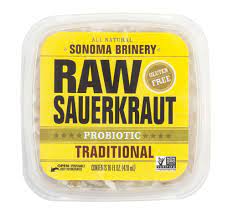
Where to find Sonoma Brinery Sauerkraut.
Sonoma Brinery is a family-run business located in Healdsburg, California. Their products are found in stores in the western U.S.
In 2004, with fresh cucumbers out of the founder’s own garden, Sonoma Brinery started making true, salt-cured kosher pickles reminiscent of the ones you could grab out of a barrel in a New York deli.
They went on to create a line of sauerkraut fermented in the traditional method.
Farmhouse Culture

Where to find Farmhouse Culture sauerkraut.
Wildbrine
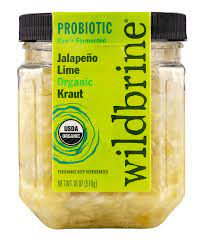
Wildbrine is a recommended brand found at Costco.
Trader Joe’s
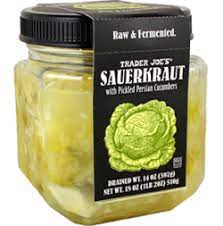
Trader Joe’s sells raw, fermented sauerkraut under their own name. It includes diced Persian cucumbers mixed in with chopped cabbage.
Ready to Make Your Own?
As your consumption of sauerkraut goes up, you may find it expensive to buy over time. You can save a lot of money by making your own sauerkraut.
Making your sauerkraut is easy, especially with my detailed, photo-rich recipes. Countless tips to ensure success.
Frequently Asked Questions
Raw sauerkraut should have a distinctively fresh smell that makes you want to eat it. It should be crisp and feel clean. You don’t want to eat the sauerkraut if it feels slimy or smells rotten.
It should be in the fridge section, the label should say “raw” and no preservatives or nasty ingredients should be listed.
Most bagged sauerkraut has been heat-processed killing beneficial bacteria and enzymes.
Read the label looking for words such as “raw,” “live,” or “unpasteurized” to make sure it has been naturally fermented and not heat processed.
The best sauerkraut to buy is sauerkraut that has been naturally fermented with just salt (no vinegar), still contains live probiotics, and does not have any nasty additives or preservatives. It will be found in the refrigerated section. It is not canned.
It is hard to recommend a particular brand. Read the label. The ingredients should be just cabbage, some flavoring vegetables, and salt.
Wildbrine is a recommended brand found at Costco. Trader Joe’s also raw, fermented sauerkraut under their own name. It includes Persian cucumbers.
No. The heat used to can sauerkraut kills off any or all live probiotics created during the fermentation process.
Yes. Heat kills off any or all live probiotics created during the fermentation process.
However, there are many delicious traditional cooked dishes that call for sauerkraut (which adds incredible flavor) that should still be made and enjoyed. I love Roasted Pork & Cabbage, which is a popular New Year’s tradition, and make it regularly, using some of my not-so-stellar batches of cabbage.
I just enjoy it with a serving of raw sauerkraut for digestive benefits. A win, win combination.
Go now—armed with the knowledge to select the Right Stuff—to your local store, grab a picture of the sauerkraut that you are able to buy, and share it in the Comment section.
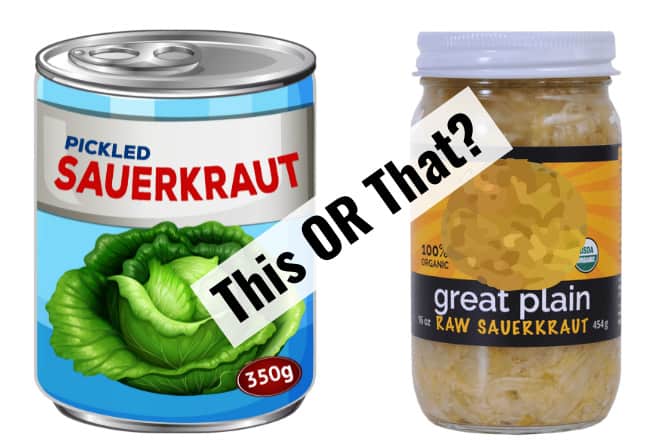
Last update on 2024-07-26 / Affiliate links / Images from Amazon Product Advertising API

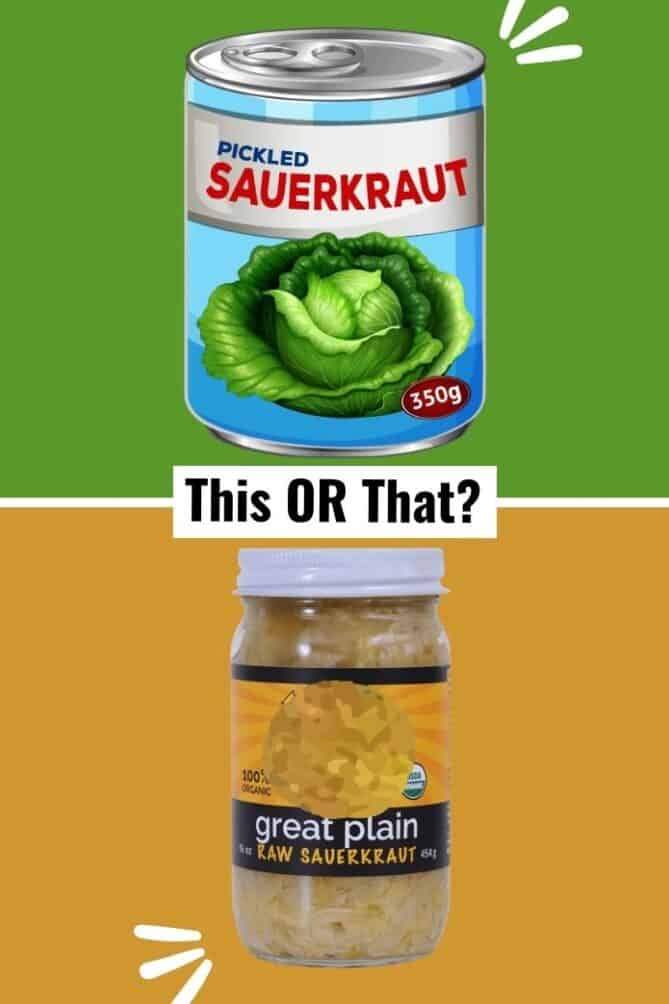

 This post may contain affiliate links which won’t change your price but will share some commission.
This post may contain affiliate links which won’t change your price but will share some commission.

